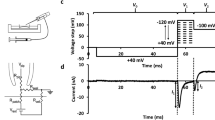Abstract
The membrane electrical parameters and component conductances of rat extensor digitorum longus muscle fibres were studied in vitro at 30 °C with standard two microelectrode square pulse cable analysis in the presence of protein kinase C (PKC) activators and inhibitors. The PKC activator, 4-β-phorbol-12,13 dibutyrate (4-β-PDB), (2–90nM) blocked up to 67% chloride conductance (G Cl) in rat skeletal muscle fibres and induced myotonic hyperexcitability. The concentration necessary to produce a 50% block of the membrane G Cl was 23 nM. The “inactive” 4-α-phorbol-12,13 dibutyrate had no effect at 2 μM. The blocking effect of 4-β-PDB on G Cl was prevented by preincubation of the preparations with the PKC inhibitors, staurosporine (1–5 μM) and tetrahydropapaverolone (50–100 μM). The blocking effects on membrane G Cl of 4-β-PDB and its antagonism by the inhibitors used support the concept of the involvement of PKC in regulating Cl channels of mammalian skeletal muscle fibres.
Similar content being viewed by others
References
Battaini F, Del Vesco R, Govoni S, Lopez CM, Trabucchi M (1990) Stressful conditions and brain transducing mechanisms during aging. In: Nappi G, Genazzani AR (eds) Stress and the aging brain. Raven, New York, pp 83–91
Brinkmeier H, Jockusch H (1987) Activators of protein kinase C induce myotonia by lowering chloride conductance in muscle. Biochem Biophys Res Commun 148:1383–1389
Bryant SH, Conte Camerino D (1991) Chloride channel regulation in skeletal muscle of normal and myotonic goats. Pflügers Arch 417:605–610
Bryant SH, Morales-Aguilera A (1971) Chloride conductance in normal and myotonic muscle fibers and the action of monocarboxylic aromatic acids. J Physiol (Lond) 219:367–383
Conte Camerino D, Mambrini M, De Luca A, Tricarico D, Bryant SH, Tortorella V, Bettoni G (1988) Enantiomers of clofibric acid analogs have opposite actions on rat skeletal muscle chloride channels. Pflügers Arch 413:105–107
Fakler B, Ruppersberg JP, Spittelmeister W, Rudel R (1990) Inactivation of sodium channels and the effect of tocainide. Pflügers Arch 415:693–700
Herbert JM, Seban E, Maffrand JP (1990) Characterization of specific binding sites for [3H]-staurosporine on various protein kinases. Biochem Biophys Res Commun 171:189–195
Hwang T, Lu L, Zeitlin PL, Gruenert DC, Hugamir R, Guggino WB (1989) Cl channels in CF: lack of inactivation by protein kinase C and cAMP-dependent protein kinase. Science 244:1351–1353
Levitan I (1985) Phosphorylation of ion channels. J Membr Biol 87:177–190
Nishizuka Y (1988) The molecular heterogenicity of protein kinase C and its implications for cellular regulation. Nature 334:661–665
Rüdel R, Lehmann-Horn F (1985) Membrane changes in cells from myotonia patients. Physiol Rev 65:310–356
Author information
Authors and Affiliations
Rights and permissions
About this article
Cite this article
Tricarico, D., Conte Camerino, D., Govoni, S. et al. Modulation of rat skeletal muscle chloride channels by activators and inhibitors of protein kinase C. Pflugers Arch. 418, 500–503 (1991). https://doi.org/10.1007/BF00497778
Received:
Revised:
Accepted:
Issue Date:
DOI: https://doi.org/10.1007/BF00497778




